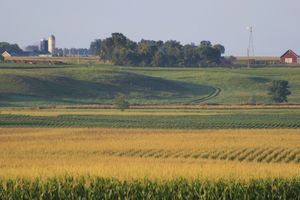With PLC Gaining Popularity, More Farmers Considering Supplemental Coverage Option
 As deadlines loom for farm bill program enrollment and crop insurance sign up, university economists are fielding a lot of questions about the Supplemental Coverage Option, a subsidized insurance product farmers can buy if they enroll in the Price Loss Coverage program.
As deadlines loom for farm bill program enrollment and crop insurance sign up, university economists are fielding a lot of questions about the Supplemental Coverage Option, a subsidized insurance product farmers can buy if they enroll in the Price Loss Coverage program.
“SCO wasn’t really a worthwhile option last time because it only applies if you choose PLC, and so few people chose PLC last time that it didn’t factor in,” said Jim Mintert, director of the Center for Commercial Agriculture at Purdue University. A majority of corn and soybean farmers chose the Agricultural Risk Coverage (ARC) program in 2014, a decision that covered five growing seasons.
The 2018 farm bill made commodity title program elections more frequent, with the deadline for farmers to sign up for the 2019 and 2020 crop years coming up on March 16. Program elections will be made annually for the 2021, 2022 and 2023 growing seasons.
Mintert, University of Illinois professor Gary Schnitkey and other university experts expect PLC will be more popular this time around, especially for corn and wheat acres, while ARC-County appears to be the best choice for soybeans based on the likelihood of those programs providing payments.
“We’ve had more interest in SCO here recently,” Schnitkey said on a recent webinar, but the ins and outs of the program can be tricky.
Most farmers, especially in major Corn Belt states such as Illinois, Indiana, Iowa, Minnesota and Nebraska, typically carry revenue protection policies (RP) that are based on their farm’s production history. Farmers choose their coverage level, which is usually 75%, 80% or 85%.
SCO provides an additional band of coverage between the farmer’s policy level and 86%, but it is factored on a county level. So, if a farmer typically carries an 80% revenue protection policy, SCO would cover from 86% down to 80%.
Mintert said the combination of a revenue protection policy and county-level product makes it “very confusing for people. It’s hard to figure out what your coverage really is.”
Historically, when farmers choose an area product, they picked the highest coverage level because it maximizes the payment, but compared to those policies, SCO’s 86% is pretty low.
“On an individual farm, you can have a 14% yield drop. Stuff can happen — didn’t get a rain, didn’t get it planted on the right day, stuff like that. But for that to apply to the whole county is always tougher,” Mintert said. “Don’t fall into the trap of thinking, if you’ve been carrying 85% that you can cut back to 80% and pick up SCO. You can do that, but don’t think you have the same coverage.”
Schnitkey also advises against lowering RP policy coverage and adding SCO. While it could result in a lower premium because SCO is subsidized at a 65% rate, “you will lower the expected payments, and you will lower risk protection.”
He also cautions that lowering your RP policy could result in lower prevented planting payments should you need to make a claim. Prevented planting payments are calculated by multiplying 55% by your coverage level, projected price and the guaranteed yield. Going from 85% to 80% would make a big difference if there are production problems like in 2019.
“Overall, we say be skeptical of lowering your RP coverage level to lower your premium and use SCO coverage on that. However, there is absolutely nothing wrong, and there’s a little bit to be gained, by putting SCO on top of RP and leaving the coverage level the same,” Schnitkey said.
If a farmer is currently taking an 85% RP policy, SCO would increase premiums by about 70 cents per acre, but Schnitkey calculates the potential payout at $1.05.
“You would be gaining a bit of premium, it’s sort of like adding a private add-on product to that policy, except that it’s subsidized at a 65% rate. So why not do it? It’s not going to offer you a whole lot of protection, but you’re picking up a penny or a nickel.”
Farmers that take lower coverage levels, like 75% or 80%, often do so to keep premiums affordable because they tend to live in higher risk areas, like southern Illinois or southern Indiana. While SCO is an option for these farmers to expand their coverage, “if you can stand the cost of adding RP coverage level, that would be better. It adds more targeted protection to your farm.”
Mintert recently compared the costs of bumping up coverage on a southern Indiana farm from 75% to 80% versus keeping 75% coverage and adding SCO. The price was similar.
“In that context, I’d lean towards, bumping my coverage 5%,” Mintert said. “At the minimum, you need to make that comparison.”
For more information on making your crop insurance decisions and how SCO fits, please check out these recent webinars. Making Your 2020 Crop Insurance Decisions by Purdue’s Center for Commercial Agriculture: https://ag.purdue.edu/… 2020 Crop Insurance Decisions by Farmdoc: https://farmdocdaily.illinois.edu/…
Katie Dehlinger can be reached at katie.dehlinger@dtn.com
You can follow her on Twitter @KatieD_DTN
Source: Katie Dehlinger, DTN
